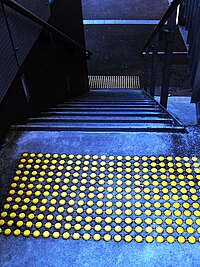
Photo from wikipedia
OBJECTIVE An important part of restoring motor control via a brain-computer interface is to close the sensorimotor feedback loop. As part of our investigations into vibrotactile kinaesthetic feedback of arm… Click to show full abstract
OBJECTIVE An important part of restoring motor control via a brain-computer interface is to close the sensorimotor feedback loop. As part of our investigations into vibrotactile kinaesthetic feedback of arm movements, we studied electroencephalographic signals in the δ, µ and β bands obtained during a center-out movement task with four conditions: movement with real-time kinaesthetic feedback, movement with static vibrations, movement without vibrotactile input, and no movement with sham feedback. APPROACH Participants performed center-out movements with their palm on a flat table surface. One of three movement directions was cued visually before the movement. The palm position was tracked in order to provide real-time vibrotactile feedback. All analyses were performed offline. MAIN RESULTS Movement-related cortical potentials exhibit minor discrepancies between movement conditions as well as between movement directions, in peak amplitude and shape. Classification of each movement condition and each direction against rest yields peak accuracies of 60%-65% using low-frequency amplitude features, and 90% using µ and β power features. Within-class accuracies of four-way classification between conditions based on low-frequency amplitude features are around chance level for the movement conditions with vibrotactile stimulation, slightly above chance level for the movement condition without stimulation, and considerably higher for the non-movement condition. Four-way classification between conditions based on µ and β power features yields within-class accuracies slightly above chance level for all movement conditions, and considerably higher for the non-movement condition. Within-class accuracies of three-way classification between directions are slightly above chance level for low-frequency amplitude features, and at chance level for power features. SIGNIFICANCE We found that the vibrotactile stimulation does not interfere with movement-related features in the δ, µ and β frequency ranges. Our feedback system may therefore feasibly be deployed in conjunction with a BCI based on movement-related cortical potentials or sensorimotor rhythms, without adversely affecting control.
Journal Title: Journal of neural engineering
Year Published: 2020
Link to full text (if available)
Share on Social Media: Sign Up to like & get
recommendations!